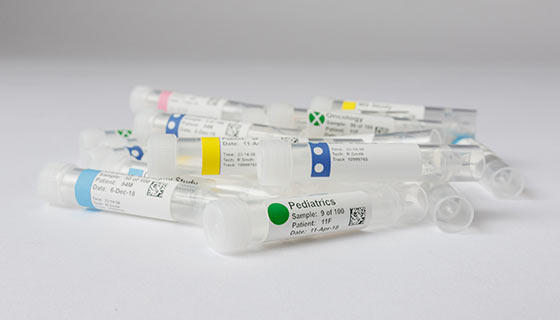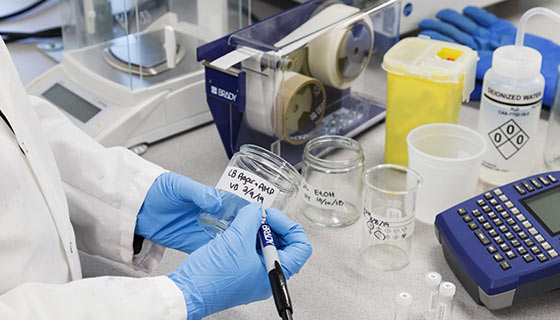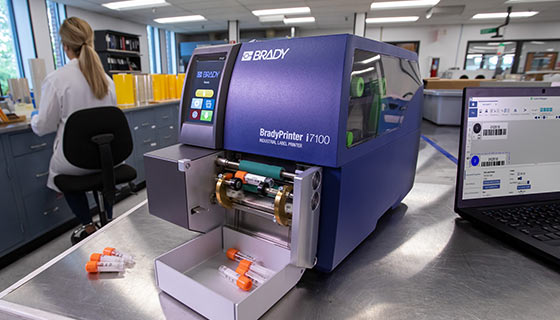Labels for Safety, Visuals and Facility ID Desktop Printers
Labels for Product, Wire and Lab ID Benchtop Printers
Labels for Safety, Visuals and Facility ID Desktop Printers
Labels for Product, Wire and Lab ID Benchtop Printers
Safety and Facility ID Desktop Printers
Product, Wire and Lab ID Benchtop Printers
Barcode Scanners and RFID Readers
PaintStripe Floor Marking Stencils
Valve Lockouts & Hose Lockouts
Group Lock Boxes & Permit Control
Pipe Marker Accessories & Mounting Brackets
Maintenance and Production Tags
Calculators and Assessment Tools
Product Finders and Data Sheets
Technology. It’s ever evolving. And automation plays a key role in streamlining many business and manufacturing processes. But automation goes broader. Laboratories look to automating processes to help them streamline sample prep and reduce manual work.

Automation happens when labs replace manual effort with technology to perform recurring tasks or processes. It’s a swap with a big impact. While labs can’t automate biological processes, they can automate labeling, sample handling and movement, liquid handling and sample analysis-- and that’s a time savings like no other.
One of the easiest-to-implement, most cost-effective ways to get started with automation in the lab is through label automation.
The 21st century has brought extraordinary medical advances that continually improve the way we diagnose, treat and cure disease. This era has also delivered incredible innovation in automating many processes that were previously done manually. But change doesn’t come without challenges. For laboratories, the rising tide of samples has put increased scrutiny on the way they identify and label samples.

Despite being an industry of precision, more than 85% of laboratories in the U.S. are still relying on markers or spreadsheets in their lab workflow for sample management. In a survey of 350 scientists, nearly 60% reported having lost samples due to label failure.
That’s a surprising matter of insecurity in such an important location.
Numerous regulators, funders and accrediting agencies have heightened their policies on sample management. The most recent regulations are centered on one primary goal: help labs mitigate or eliminate sample loss.
The U.S. Bureau of Labor Statistics predicts that between 2018 and 2028, the demand for skilled medical laboratory professionals will increase by 11%.
Many laboratories are struggling with a shrinking workforce, especially in the clinical and diagnostic space. From 2007 to 2017 the number of active pathologists decreased by 17.5%. In addition, there are fewer people graduating with degrees to fill these roles. While there were 18,000 clinical laboratory science vacancies in 2018, only 5,000 students graduated from accredited CLS programs. This workforce is also aging, with the average age increasing from 45.1 to 48.6 years old between 1993 and 2010.
Between lab techs and analytical equipment, bench space is at a premium. It’s necessary to squeak more into smaller spaces. And with recent social distancing measures, labs are more strained for space than ever.
Now more than ever, labs are working around the clock to deliver the data and results that will lead to clinical knowledge. The more quickly a lab can produce products, the more quickly they can generate revenue through sales or grant funding.
Three areas can find great improvement by putting label automation to play in the lab:
Vial label applicators automatically take printed labels and apply them to tubes and vials. That way, busy techs can reduce their labeling time – a solution you can’t afford to pass up. With automated efficiency, these applicators can improve workflow and accuracy.

Label materials should be engineered to survive and perform in the harsh chemicals and range of temperatures of the lab environment. These durable labels remain legible and stay put on lab equipment to eliminate rework and tedious label reapplication.



Save time. It can take 10 seconds to hand write and apply a label to a test tube. Label automation can print and apply a label in just 2 seconds. If your lab labels 80,000 tubes every month, that adds up to 178 hours saved every month. What could your lab do with 178 extra hours?
Smart investment. Many automation solutions come with a six-figure price tag. But label printers and applicators are an easy, cost-effective way to implement automation in your lab to immediately see productivity without blowing the budget.

Flexible solution. Add labeling technology as your budget allows throughout the fiscal year to improve budgeting and plan for expenditures. For example, you can start with a printer, then add an applicator at a later date. Build it as you need it.

Easy label creation. Label software allows you to drag and drop Excel files into the system to easily create labels that are crisp, clear and readable.

The right label for the job. Label automation includes high-quality labels that won’t come off, smear or fade, and are durable and resistant to chemicals. No more attaching handwritten labels to test tubes with tape.

Less handling, more safety. Label automation means less physical handling of the test tubes, which prevents warming up tubes and helps keep them at the right temperature for your processes.
As experts in the lab space, Brady can recommend how to use lab automation to streamline workflow, increase output and decrease errors. For a relatively small investment, your lab can automate the labeling process and put you in a confident place to produce knowledge and data more quickly.
Our laboratory labeling software is written specifically for the lab to help you easily and efficiently create labels and lab ID.

We offer a variety of laboratory label printers to meet your lab’s specific needs and help you save significant labeling time.

The BradyPrinter i7100 Vial Label Applicator helps labs replace handwritten and hand-applied labels in favor of a faster, more efficient process. Working with the BradyPrinter i7100 Industrial Label printer peel model, this device can improve both workflow and accuracy. Even better? This device pays for itself in approximately 100 hours.


Brady offers a variety of thermal transfer label materials engineered to survive and perform in the harsh chemicals and range of temperatures of the lab environment. In sub arctic temps or heat like no other, these durable laboratory labels remain legible and in place when put to the test making them ideal for the biotech, pharmaceutical, academic, industrial and health care industries.
Contact a Brady representative at 1-800-356-9951 for more information.